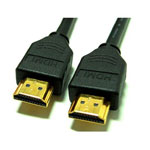Difference between revisions of "HDMI connections"
(No difference)
|
Latest revision as of 07:06, 12 November 2012
The High-Definition Multi-media (HDMI)is an industry-supported digital audio/video interface. HDMI provides connection between any compatible digital audio/video source and a compatible digital audio and/or video monitor. HDMI supports standard, enhanced, or high-definition video, plus multi-channel digital audio on a single cable. It is independent of the various DTV standards such as ATSC, DVB(-T,-S,-C), as these are encapsulations of the MPEG data streams, which are passed off to a decoder, and output as uncompressed video data, which can be high-definition. This video data is then encoded into TMDS for transmission digitally over HDMI. HDMI also includes support for 8-channel uncompressed digital audio. Beginning with version 1.2, HDMI now supports up to 8 channels of one-bit audio. One-bit audio is what is used on Super Audio CDs.
The standard Type A HDMI connector has 19 pins, and a higher resolution version called Type B, has been defined, although it is not yet in common use. Type B has 29 pins, allowing it to carry an expanded video channel for use with high-resolution displays. Type-B is designed to support resolutions higher than 1080p. HDMI version 1.4 has just (Nov 2009) been released and includes extra data wires for internet connections in the cable.

|
Connections as seen at the socket |

|
| Pin | Signal | Description |
| 1 | TMDS Data2+ | |
| 2 | TMDS Data2 Shield | |
| 3 | TMDS Data2- | |
| 4 | TMDS Data1+ | |
| 5 | TMDS Data1 Shield | |
| 6 | TMDS Data1- | |
| 7 | TMDS Data0+ | |
| 8 | TMDS Data0 Shield | |
| 9 | TMDS Data0- | |
| 10 | TMDS Clock+ | |
| 11 | TMDS Clock Shield | |
| 12 | TMDS Clock- | |
| 13 | TMDS Data5+ | |
| 14 | TMDS Data5 Shield | NC on Device |
| 15 | TMDS Data5- | |
| 16 | TMDS Data4+ | |
| 17 | TMDS Data4 Shield | |
| 18 | TMDS Data4- | |
| 19 | TMDS Data3+ | |
| 20 | TMDS Data3 Shield | |
| 21 | TMDS Data3- | |
| 22 | CEC | |
| 23 | Reserved | (N.C. on device) |
| 24 | Reserved | (N.C. on device) |
| 25 | SCL | |
| 26 | SDA | |
| 27 | DDC/CEC Ground | |
| 28 | +5V | |
| 29 | Hot Plug Detect |
TMDS channel carries audio, video and auxiliary data.
Signalling method: According to DVI 1.0 spec. Single-link (Type A HDMI) or dual-link (Type B HDMI).
Video pixel rate: 25 MHz to 165 MHz (Type A) or to 330 MHz (Type B). Video formats with rates below 25 MHz (e.g. 13.5 MHz for 480i/NTSC) transmitted using a pixel-repetition scheme. Up to 24 bits per pixel can be transferred, regardless of rate. Supports 1080p60.
Pixel encodings: RGB 4:4:4, YCbCr 4:4:4 (8 bits per component); YCbCr 4:2:2 (12 bits per component).
Audio sample rates: 32 kHz, 44.1 kHz, 48 kHz, 88.2 kHz, 96kHz, 176.4 kHz, 192 kHz, up to 8 audio channels .
Type A HDMI is backward-compatible with the single-link Digital Visual Interface (DVI) used on modern computer monitors and graphics cards. This means that a DVI source can drive an HDMI monitor, or vice versa, by means of a suitable adapter or cable, but the audio and remote control features of HDMI will not be available. Additionally, without support for HDCP, the video quality and resolution may be artificially downgraded by the signal source to prevent the end user from viewing or especially copying restricted content. Type B HDMI is similarly backward-compatible with dual-link DVI.